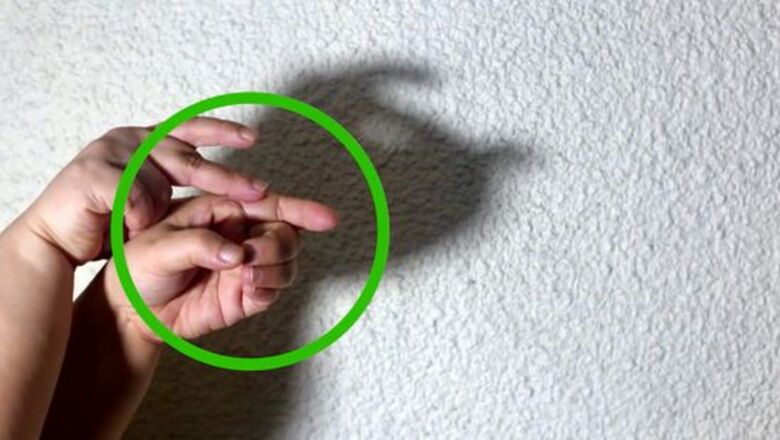
views
Making Easy Hand Shadow Puppets
Make a two-handed bird. Out of all the hand puppets you can make, this is probably the easiest, making it a great choice for young kids who want to participate in the fun but aren't coordinated enough to try some of the harder puppets. To make the bird, simply turn your hands so that your palms face you, cross your hands over each other, and lock your thumbs together. Stretch your palms open to make the bird's wings. To make the bird "fly", curl your fingers inward, then outward again.
Make a one-handed greyhound. This hand puppet is also quite easy, though it requires you to extend your ring finger and little finger without extending the rest of your fingers, which can be tricky for some people. To make the greyhound, start by raising your hand in a fist with your thumb facing you. Raise your little finger and ring finger so that they're parallel to the floor while keeping your index and ring finger curled in. Raise your thumb slightly to make the dog's ear. To make the dog's mouth move, move your little finger up and down.
Make a swan. This shadow puppet uses both hands and part of one arm, making it one of the biggest ones out there. To make the swan, begin by raising one arm, bending it at the elbow, and bringing the tips of the fingers together so that they make a point. With your other hand, spread your fingers wide and put the fleshy part of your palm on your bicep to make the swan's tail feathers.
Make a one-handed camel. This shadow puppet is a great stepping stone for beginners looking to branch out into more difficult puppets. To make the camel, raise one arm, bending it at the elbow so that your hand points toward the ceiling. Curve your middle and ring fingers forward gently while you arch your index finger back to make the camel's eye — get used to doing this, as it's something that's used in many of the more advanced puppets. Let your little finger droop slightly to form the camel's bottom lip. Tuck your thumb out of the way behind your hand. To make the camel's mouth move, let your little finger bounce up and down limply.
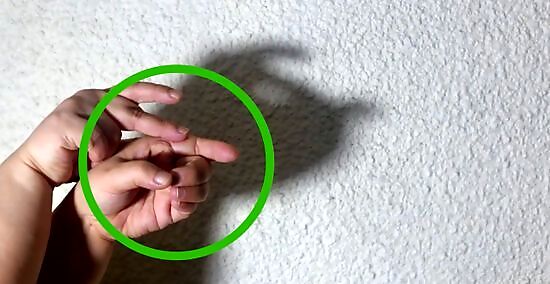
Make an old man. This shadow puppet is great for puppet shows because it's easy to make him "talk." To make the old man, raise your palm, then point your index finger forward. Curve your middle, ring, and little fingers in an arc to form the man's eye. Bend your thumb in and raise it up to the index finger to form the man's jaw. Making the man talk is a cinch — just move your thumb back and forth to match the words you say.
Making Hard Hand Shadow Puppets
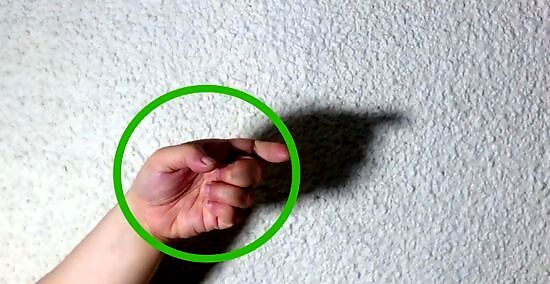
Make a face. This tricky shadow puppet makes full use of both hands, but is positively lifelike when pulled off well. To start, face your left palm toward yourself and make a ring with your middle finger and thumb. Bring your ring and little fingers together and curl them inward. Let your index finger lay on top of the ring formed by your middle finger ad thumb, sticking out slightly. With your right hand, face your palm toward the floor, curl your little and ring fingers in, and make an arc with your index and middle finger to form the face's eye. Lay this over your other hand palm-down to complete the puppet. To make the face talk, you need to move the ring and little finger on your left hand up and down independently from the rest of your hand. This can be quite tricky, so practice!
Make a bulldog. The hardest part of this shadow puppet isn't what you need to do with your fingers, but the way you need to orient your hands. With your left hand, face your palm toward the ground, curl all of your fingers except your thumb inward at the second knuckle, and bend the thumb underneath. With your right hand, curl all of your fingers except your thumb in an arc to make the bulldog's eye and raise your thumb to make its ear. Finally, put your right hand on top of your left so that all of your knuckles are facing the same way and align your hands just right so that the bulldog is visible — harder than it sounds! To make the bulldog bark, move your left thumb up and down.
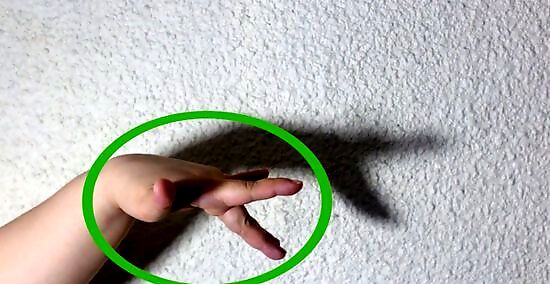
Make an elephant. This puppet's trunk requires a unique arrangement of the middle and ring fingers. To start, face your left hand's palm toward the ground. Point your ring and middle fingers toward the ground while keeping your little and index fingers straight (like a "rock on" gesture). Bend your thumb and tuck it under the hand. Place your right hand palm-down on top of your left hand and bend all of your fingers except your thumb to make the elephant's eye. Try moving the middle and ring fingers on your left hand to make the elephant's trunk move — you can also make it talk with the thumb on your left hand.
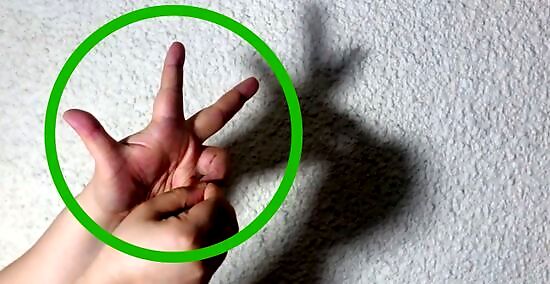
Make a deer. This puppet can take lots of practice, but it looks amazing when it's perfected. To start, face your left palm toward the ground and bring your index, middle, and ring fingers together in a point. Tuck your thumb under your hand and extend your little finger straight slightly under your other fingers. Place the fleshy part of your right palm on the back of your left hand and extend your thumb, index, and middle fingers upward. Curve your ring and little finger to make the deer's eye. To make the deer talk, move the little finger on your left hand up and down. Be gentle — deer are usually quiet and composed (until they're startled by a friend's elephant puppet, of course).
Make a doggy. This hand puppet makes a pretty convincing terrier or dachshund. Start by raising your right arm and bending it at the elbow so that the hand points at the ceiling. Bend your little and ring fingers down so they point forward. Bring your middle finger over your index finger and arch it to make the dog's eye. Tuck your thumb up into the crook of your index finger. Bring the palm of your left hand against the side of your right forearm and extend your index and middle fingers while sticking your thumb behind the forearm to make the dog's tail. Keep your left ring and little fingers tucked out of the way. Unfortunately, there isn't an easy way to make the dog talk, so you'll just have to use your puppet's "body language" to express its emotions!
Making Paper Shadow Puppets
Gather your materials. If you're having a hard time contorting your hands into the bizarre shapes needed to make hand shadow puppets, don't worry! You can make wonderful, detailed miniature shadow puppets with just a few common materials you'll probably have lying around the house. For this project, you’ll need: Construction paper A light source (like a lamp or light bulb) A cardboard box (for your "stage") Straws or balsa wood sticks Tape Thin tissue paper or baking parchment (for your “screen”)
Build your "stage". To begin, cut the bottom out of the cardboard box, leaving a 5 cm (about 2 inches) border around the edges. Next, fasten a thin sheet of tissue or baking paper onto the frame with tape or glue so that it covers the hole you've just cut. This will be the "screen" for your puppet show — you'll hold your puppets in between your light source and the paper to project their images onto the screen.
Design and draw your puppets. Next, grab a sheet of construction paper or cardboard (whatever you use, it should be thick enough that light doesn't shine through it). Draw the outlines of your puppets on this paper or cardboard. Your puppets can be as simple or as detailed as you like, so be creative! One good idea is to draw small details like eyes or smiles on the puppet so that, when it's cut out, these details will appear in its shadow. However, this can require some tricky detail work on your part — you may need to use an X-acto knife to make these small cuts in the middle of the puppet.
Cut out your puppets.When you're satisfied with the designs of your puppets, use a pair of scissors to carefully cut along the outlines you drew. As noted above, for minor details like eyes, facial features, hair, and so on, you may need to use a small, sharp X-acto knife. Another good idea is to use the sorts of special children's scissors that are often sold at back-to-school sales. These scissors can sometimes have designs like zigzag lines and curves incorporated into the blades of the scissors, making it easy to make these sorts of designs in your puppets.
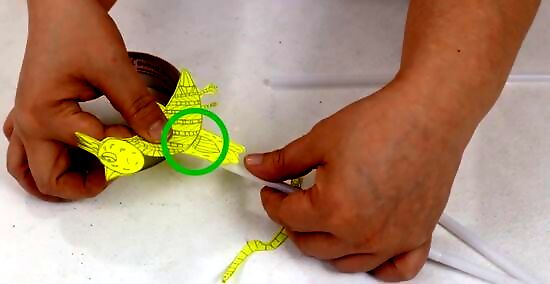
Attach sticks to your puppets. Grab a thin wooden stick (like a coffee stirrer or popsicle stick) or a drinking straw for each puppet. Put a piece of tape or a drop of glue on one side of each stick or straw. Fasten the sticks or straws to the backs of your paper puppets. If you're using glue, give it time to dry before using your puppets. For especially big puppets (or puppets with moving parts), you may need to use more than one stick.
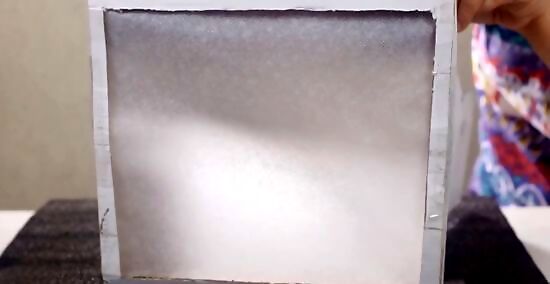
Get ready for your show. Grab an audience, and, if needed, a few friends to act in the show with you. Position the box so that your paper "screen" is facing the audience, then crouch behind the box. Make sure that you can easily fit your hands into the box — if you need to, you may want to cut the sides of the cardboard box down a little to make it easier to put your hands in. As long as your box can still stand up on its own, anything you do to it is fair game. You'll also want to put your light source (lamp, lightbulb, flashlight, etc.) behind the box so that its light shines clearly through the box and out of the screen. This light will make the puppets cast their shadows on the screen during your show.

Start your show. If you're not already behind the box, duck behind it, making sure it's positioned with the screen in front of you, and the audience in the front of the screen. Grab all of your puppets and turn on the light behind the box. Finally, turn off the light in the room. Showtime! Move your puppets between your light source and the box so that their shadows project onto the thin paper screen for your audience. Break a leg! If you can't get it dark enough in the room for your puppets to cast clear shadows on the screen, try drawing all of the curtains in the room to keep light from outside from entering.

















Comments
0 comment